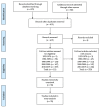The Profile of Moods States and Athletic Performance: A Meta-Analysis of Published Studies
- PMID: 34542449
- PMCID: PMC8314345
- DOI: 10.3390/ejihpe11010005
The Profile of Moods States and Athletic Performance: A Meta-Analysis of Published Studies
Erratum in
-
Correction: Lochbaum et al. The Profile of Moods States and Athletic Performance: A Meta-Analysis of Published Studies. Eur. J. Investig. Health Psychol. Educ. 2021, 11, 50-70.Eur J Investig Health Psychol Educ. 2021 Jun 9;11(2):513-514. doi: 10.3390/ejihpe11020036. Eur J Investig Health Psychol Educ. 2021. PMID: 34708823 Free PMC article.
Abstract
Researchers have extensively examined and reviewed the relationship of the profile of mood states (POMS) with sport performance since the 1970s. Two decades have passed since the last POMS quantitative review. Our overall objective was to quantify the POMS research with competitive athletes with a prospective measured POMS and a sport performance outcome in the published literature. Additionally, we tested potential moderators of the mental health model (i.e., sport duration, type, and skill) with meta-analytic techniques while considering potential risk bias across study sources. Based on a systematic review, the articles were found using EBSCO and comparing these articles with extensive past POMS in sport and exercise bibliographies. Search terms included profile of mood states (POMS) or iceberg profile or the mental health model with sport and performance or sports performance. For selection, articles must have reported data on competitive athletes, an athletic performance outcome, and a valid form of the POMS measured prospectively. After screening more than 600 articles for inclusion, 25 articles provided sufficient data for effect size calculations. The included articles spanned from 1975 to 2011, with 1497 unique participants. Hedges' g values were generally small for the six POMS scales: tension (-0.21), depression (-0.43), anger (-0.08), vigor (0.38), fatigue (-0.13), and confusion (-0.41). However, the total mood disturbance (TMD) score effect size was medium in magnitude at -0.53. When corrected for potential publication bias, the effect size values increased in magnitude for tension (-0.47), depression (-0.64), vigor (0.44), fatigue (-0.34), and TMD (-0.84). Moderator analyses for Terry's (1995) propositions and for risk of bias across studies, statistically, resulted in few differences based on conventional statistical significance (p < 0.05). Measured before performance, most of the POMS scales and TMD are reliable predictors of sport performance in competitive athletes across a wide variety of sports and athletic performance outcomes. Morgan's (1980, 1985) mental health model or iceberg profile minus anger is still a viable method for understanding and improving athletic performances.
Keywords: depression; iceberg profile; mental health model; quantitative review; total mood disturbance; vigor.
Conflict of interest statement
The authors declare no conflict of interest.
Figures















References
-
- Lochbaum M. Understanding the meaningfulness and potential impact of sports psychology on performance. In: Milanović D., Sporiš G., Šalaj S., Škegro D., editors. Proceedings Book of 8th International Scientific Conference on Kinesiology, Opatija. Faculty of Kinesiology, University of Zagreb; Zagreb, Croatia: 2017. pp. 486–489.
-
- Kyllo L.B., Landers D.M. Goal setting in sport and exercise: A research synthesis to resolve the controversy. J. Sport Exerc. Psychol. 1995;17:117–137. doi: 10.1123/jsep.17.2.117. - DOI
-
- Lochbaum M., Gottardy J. A meta-analytic review of the approach-avoidance achievement goals and performance relationships in the sport psychology literature. J. Sport Health Sci. 2015;4:164–173. doi: 10.1016/j.jshs.2013.12.004. - DOI
-
- Toth A.J., McNeill E., Hayes K., Moran A.P., Campbell M. Does mental practice still enhance performance? A 24 Year follow-up and meta-analytic replication and extension. Psychol. Sport Exerc. 2020;48:101672. doi: 10.1016/j.psychsport.2020.101672. - DOI
-
- Castaño N., Watts T., Tekleab A.G. A reexamination of the cohesion–performance relationship meta-analyses: A comprehensive approach. Group Dynam. Theory Res. Prac. 2013;17:207–231. doi: 10.1037/a0034142. - DOI
Publication types
LinkOut - more resources
Full Text Sources
Medical
Miscellaneous

